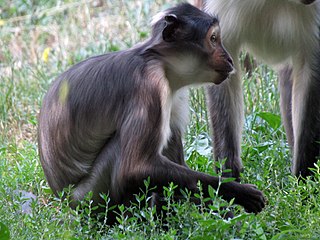 W
WThe white-eyelid mangabeys are African Old World monkeys belonging to the genus Cercocebus. They are characterized by their bare upper eyelids, which are lighter than their facial skin colouring, and the uniformly coloured hairs of the fur. The other two genera of mangabeys, Lophocebus and Rungwecebus, were once thought to be very closely related to Cercocebus, so much so that all the species were placed in one genus. However, it is now understood that Lophocebus and Rungwecebus species are more closely related to the baboons in genus Papio, while the Cercocebus species are more closely related to the mandrill.
 W
WThe white-eyelid mangabeys are African Old World monkeys belonging to the genus Cercocebus. They are characterized by their bare upper eyelids, which are lighter than their facial skin colouring, and the uniformly coloured hairs of the fur. The other two genera of mangabeys, Lophocebus and Rungwecebus, were once thought to be very closely related to Cercocebus, so much so that all the species were placed in one genus. However, it is now understood that Lophocebus and Rungwecebus species are more closely related to the baboons in genus Papio, while the Cercocebus species are more closely related to the mandrill.
 W
WThe agile mangabey is an Old World monkey of the white-eyelid mangabey group found in swampy forests of Central Africa in Equatorial Guinea, Cameroon, Gabon, Central African Republic, Republic of Congo, and DR Congo. Until 1978, it was considered a subspecies of the Tana River mangabey. More recently, the golden-bellied mangabey has been considered a separate species instead of a subspecies of the agile mangabey.
 W
WThe collared mangabey, also known as the red-capped mangabey, or the white-collared mangabey, is a species of primate in the family Cercopithecidae of Old World monkeys. It formerly included the sooty mangabey as a subspecies. As presently defined, the collared mangabey is monotypic.
 W
WThe collared mangabey, also known as the red-capped mangabey, or the white-collared mangabey, is a species of primate in the family Cercopithecidae of Old World monkeys. It formerly included the sooty mangabey as a subspecies. As presently defined, the collared mangabey is monotypic.
 W
WThe golden-bellied mangabey is a social Old World monkey found in swampy, humid forests south of the Congo River in the Democratic Republic of the Congo. It was previously considered a subspecies of the agile mangabey . Little is published about the species and its behaviour has only been studied in captivity.
 W
WThe Sanje mangabey is a highly endangered Old World monkey of the white-eyelid mangabey group from the Eastern Arc Mountains in Tanzania. They are about 50–65 centimetres (20–26 in) in length, excluding the tail, and their body colour is greyish. Fruit makes up about 70% of their diet. They live in valley forests and on mountain slopes, but are mostly ground-dwelling, which makes them susceptible to hunting and poaching. Their habitat is being degraded, and the International Union for Conservation of Nature has assessed their conservation status as being "endangered".
 W
WThe sooty mangabey is an Old World monkey found in forests from Senegal in a margin along the coast down to the Ivory Coast.
 W
WThe Tana River mangabey is a highly endangered species of primate in the family Cercopithecidae. Some authorities have included the taxa agilis and sanjei as subspecies of this species, while others award these full species status.